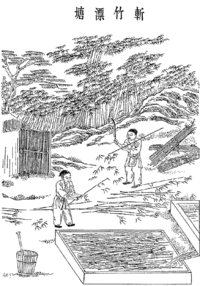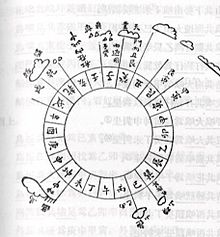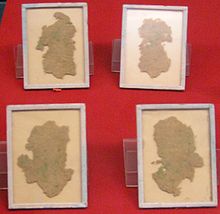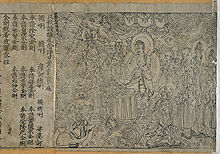- Four Great Inventions
-
Four Great Inventions 
Five major steps in papermaking, outlined by Cai Lun in AD 105 Traditional Chinese 四大發明 Simplified Chinese 四大发明 Literal meaning four great inventions Transcriptions Mandarin - Hanyu Pinyin sì dà fā míng The Four Great Inventions are the inventions that are celebrated in Chinese culture for their historical significance and serve as symbols of China's advanced science and technology.[1]
The Four Great Inventions are:
These four discoveries had an enormous impact on the development of Chinese civilization and a far-ranging global impact.[6] However, some modern Chinese scholars have pointed out that other inventions in China were perhaps more sophisticated and had a greater impact on civilization – the Four Great Inventions serve merely to highlight the technological interaction between East and West.[7]
Contents
Origins
History of science and
technology in ChinaInventions Discoveries By era Han Dynasty Tang Dynasty Song Dynasty People's Republic of China Present-day China This box: view · Four Great Beauties, Four Great Books of Song, Four Great Classical Novels, Four Books, etc.), the concept of the Four Great Inventions originated with European scholars, and was only later adopted by the Chinese. The importance of these inventions was perhaps first discussed by the British philosopher Francis Bacon (1561–1626), who in 1620 wrote: "Printing, gunpowder and the compass ... whence have followed innumerable changes, in so much that no empire, no sect, no star seems to have exerted greater power and influence in human affairs than these mechanical discoveries."[8] Bacon was likely unaware of the origins of these inventions, and was not writing of the ancient Chinese inventions but rather their Western analogs. However, his writings do show the importance of these technologies to the early-modern European world.
Later, Karl Marx also commented that, "Gunpowder, the compass, and the printing press were the three great inventions which ushered in bourgeois society. Gunpowder blew up the knightly class, the compass discovered the world market and founded the colonies, and the printing press was the instrument of Protestantism and the regeneration of science in general; the most powerful lever for creating the intellectual prerequisites."[9]
The modern list of the Four Great Inventions originated in the mid-19th century with the missionary and Sinologist Joseph Edkins (1823–1905)'s writings about China.[10] In particular, Edkins' notes on these inventions were mentioned in an 1859 review in the journal Athenaeum, comparing the contemporary science and technology in China and Japan.[11] This list was later popularized and augmented by the noted British biochemist, historian, and Sinologist Joseph Needham, who devoted the later part of his life to studying the science and civilization of ancient China.[12]
The Four Great Inventions
Further information: List of Chinese inventionsCompass
Main article: CompassThe earliest reference to magnetism in Chinese literature is found in the 4th-century BC Book of the Devil Valley Master (Guiguzi): "The lodestone makes iron come, or it attracts it."[13]
The earliest reference to a magnetic device used as a "direction finder" is in a Song Dynasty book dated to AD 1040-44. Here there is a description of an iron "south-pointing fish" floating in a bowl of water, aligning itself to the south. The device is recommended as a means of orientation "in the obscurity of the night."[13] However, the first suspended magnetic needle compass was written of by Shen Kuo in his book of AD 1088.
For most of Chinese history, the compass that remained in use was in the form of a magnetic needle floating in a bowl of water.[14] According to Needham, the Chinese in the Song Dynasty and continuing Yuan Dynasty did make use of a dry compass, although this type never became as widely used in China as the wet compass.[15]
The dry compass used in China was a dry suspension compass, a wooden frame crafted in the shape of a turtle hung upside down by a board, with the lodestone sealed in by wax, and if rotated, the needle at the tail would always point in the northern cardinal direction.[15] Although the 14th-century European compass-card in box frame and dry pivot needle was adopted in China after its use was taken by Japanese pirates in the 16th century (who had in turn learned of it from Europeans), the Chinese design of the suspended dry compass persisted in use well into the 18th century.[12]
Gunpowder
 Handgun from the Yuan dynasty, circa 1300s.
Handgun from the Yuan dynasty, circa 1300s. Main article: History of gunpowder
Main article: History of gunpowderThe prevailing academic consensus is that gunpowder was discovered in the 9th century by Chinese alchemists searching for an elixir of immortality.[16] By the time the Song Dynasty treatise, Wujing Zongyao (武经总要), was written by Zeng Gongliang and Yang Weide in AD 1044, the various Chinese formulas for gunpowder held levels of nitrate in the range of 27% to 50%.[17] By the end of the 12th century, Chinese formulas of gunpowder had a level of nitrate capable of bursting through cast iron metal containers, in the form of the earliest hollow, gunpowder-filled grenade bombs.[18]
In AD 1280, the bomb store of the large gunpowder arsenal at Weiyang accidentally caught fire, which produced such a massive explosion that a team of Chinese inspectors at the site a week later deduced that some 100 guards had been killed instantly, with wooden beams and pillars blown sky high and landing at a distance of over 10 li (~2 mi. or ~3.2 km) away from the explosion.[19]
By the time of Jiao Yu and his Huolongjing (a book written by Jiao Yu that describes military applications of gunpowder in great detail) in the mid 14th century, the explosive potential of gunpowder was perfected, as the level of nitrate in gunpowder formulas had risen to a range of 12% to 91%,[17] with at least 6 different formulas in use that are considered to have maximum explosive potential for gunpowder.[17] By that time, the Chinese had discovered how to create explosive round shot by packing their hollow shells with this nitrate-enhanced gunpowder.[20]
Papermaking
Main article: PapermakingFurther information: Science and technology of the Han DynastyPapermaking has traditionally been traced to China about AD 105, when Cai Lun, an official attached to the Imperial court during the Han Dynasty (202 BC-AD 220), created a sheet of paper using mulberry and other bast fibres along with fishnets, old rags, and hemp waste.[21] However a recent archaeological discovery has been reported from near Dunhuang of paper with writing on it dating to 8 BC.[22]
While paper used for wrapping and padding was used in China since the 2nd century BC,[23] paper used as a writing medium only became widespread by the 3rd century.[24] By the 6th century in China, sheets of paper were beginning to be used for toilet paper as well.[25] During the Tang Dynasty (AD 618–907) paper was folded and sewn into square bags to preserve the flavor of tea.[23] The Song Dynasty (AD 960–1279) that followed was the first government to issue paper currency.
Printing
Main article: History of printing in East AsiaThe Chinese invention of Woodblock printing, at some point before the first dated book in 868 (the Diamond Sutra), produced the world's first print culture. According to A. Hyatt Mayor, curator at the Metropolitan Museum of Art, "it was the Chinese who really discovered the means of communication that was to dominate until our age."[26] Woodblock printing was better suited to Chinese characters than movable type, which the Chinese also invented, but which did not replace woodblock printing. Western printing presses, although introduced in the 16th century, were not widely used in China until the 19th century. China, along with Korea, was one of the last countries to adopt them.[27]
Woodblock printing for textiles, on the other hand, preceded text printing by centuries in all cultures, and is first found in China at around 220,[28] then Egypt in the 4th century,[29] and reached Europe by the 14th century or before, via the Islamic world, and by around 1400 was being used on paper for old master prints and playing cards.[30][31]
Printing in China was further advanced by the 11th century, as it was written by the Song Dynasty scientist and statesman Shen Kuo (1031–1095) that the common artisan Bi Sheng (990-1051) invented ceramic movable type printing.[32] Then there were those such as Wang Zhen (fl. 1290-1333) and Hua Sui (1439–1513), who invented respectively wooden[33] and metal[34] movable type printing. Movable type printing was a tedious process if one were to assemble thousands of individual characters for the printing of simply one or a few books, but if used for printing thousands of books, the process was efficient and rapid enough to be successful and highly employed. Indeed, there were many cities in China where movable type printing, in wooden and metal form, was adopted by the enterprises of wealthy local families or large private industries. The Qing Dynasty court sponsored enormous printing projects using woodblock movable type printing during the 18th century. Although superseded by western printing techniques, woodblock movable type printing remains in use in isolated communities in China.[35]
Depiction in media
2005 Hong Kong stamp issue
In 2005, the Hong Kong postal service created a special stamp issue that featured the Four Great Inventions. The stamp series was introduced with a first day cover issue at an opening ceremony that officiated by the Hong Kong Postmaster General. The President of the Hong Kong University of Science and Technology marked the issue of the special stamps by personally stamping a first day cover.[36][37][38]
2008 Beijing Olympics
The Four Great Inventions was featured as one of the main themes of the opening ceremony of the 2008 Beijing Summer Olympics.[39] Paper making was represented with a dance and an ink drawing on a huge piece of paper, printing by a set of dancing printing blocks, a replica of an ancient compass was showcased, and gunpowder by the extensive firework displays during the ceremony. A survey by the Beijing Social Facts & Public Opinion Survey Center found that Beijing residents found the program on the Four Great Inventions the most moving part of the opening ceremony.[40]
Scholarly critiques
Recently, scholars have questioned the importance placed on the inventions of paper, printing, gunpowder, and the compass. Chinese scholars in particular question if too much emphasis is given to these inventions, over other significant Chinese inventions. They have pointed out that other inventions in China were perhaps more sophisticated and had a greater impact within China.[7]
In the chapter "Are the Four Major Inventions the Most Important?" of his book Ancient Chinese Inventions, Chinese historian Deng Yinke writes:[41]
The four inventions do not necessarily summarize the achievements of science and technology in ancient China. The four inventions were regarded as the most important Chinese achievements in science and technology, simply because they had a prominent position in the exchanges between the East and the West and acted as a powerful dynamic in the development of capitalism in Europe. As a matter of fact, ancient Chinese scored much more than the four major inventions: in farming, iron and copper metallurgy, exploitation of coal and petroleum, machinery, medicine, astronomy, mathematics, porcelain, silk, and wine making. The numerous inventions and discoveries greatly advanced China's productive forces and social life. Many are at least as important as the four inventions, and some are even greater than the four.See also
- Dream Pool Essays
- Gunpowder warfare
- History of science and technology in China
- List of Chinese inventions
- Science and technology of the Han Dynasty
- Technology of the Song Dynasty
Notes
- ^ "The Four Great Inventions". China.org.cn. http://www.china.org.cn/e-gudai/8.htm. Retrieved 2007-11-11.
- ^ "Four Great Inventions of Ancient China -- Compass". ChinaCulture.org. http://www.chinaculture.org/gb/en_aboutchina/2003-09/24/content_26519.htm. Retrieved 2007-11-11.
- ^ "Four Great Inventions of Ancient China -- Gunpowder". ChinaCulture.org. http://www.chinaculture.org/gb/en_aboutchina/2003-09/24/content_26504.htm. Retrieved 2007-11-11.
- ^ "Four Great Inventions of Ancient China -- Paper". ChinaCulture.org. http://www.chinaculture.org/gb/en_aboutchina/2003-09/24/content_26514.htm. Retrieved 2007-11-11.
- ^ "Four Great Inventions of Ancient China -- Printing". ChinaCulture.org. http://www.chinaculture.org/gb/en_aboutchina/2003-09/24/content_26509.htm. Retrieved 2007-11-11.
- ^ Although he was unaware of their origins, Francis Bacon wrote of the importance of these technologies to the medieval world: "Printing, gunpowder and the compass: These three have changed the whole face and state of things throughout the world; the first in literature, the second in warfare, the third in navigation; whence have followed innumerable changes, in so much that no empire, no sect, no star seems to have exerted greater power and influence in human affairs than these mechanical discoveries." Novum Organum, Book I, CXXIX
- ^ a b "Do We Need to Redefine the Top Four Inventions?". Beijing Review (35). 2008-08-26. http://www.bjreview.com.cn/special/txt/2008-08/26/content_146777.htm. Retrieved 2008-11-04.
- ^ Novum Organum, Book I, CXXIX
- ^ Marx, Karl. "Division of Labour and Mechanical Workshop. Tool and Machinery". Economic Manuscripts of 1861-63. http://www.marxists.org/archive/marx/works/1861/economic/ch35.htm.
- ^ Edkins, Joseph (1859). The religious condition of the Chinese: With observations on the prospects of christian conversion amongst that people. Routledge-Warnes and Routledge. p. 2. "...remarkable inventions and discoveries, such as printing, paper-making, the mariner's compass, and the composition of gun-powder."
- ^ Maurice, Frederick Denison, Charles Wentworth Dilke, Thomas Kibble Hervey, William Hepworth Dixon et al (1859). The Athenæum: a journal of literature, science, the fine arts, music, and the drama. J. Francis. p. 839. "Japan, he thinks, intelligent and civilized as it may be, must not be compared with China. Clean and wide are its streets, sharp-eyed are its police, quick are its linguists, and cleverly do its craftsmen learn to manage steam-engines. But it invented no paper-manufacture, no printing-press, no gunpowder, no mariner's compass."
- ^ a b Needham, IV 1, p. 290
- ^ a b Shu-hua, Li (July 1954). "Origine de la Boussole 11. Aimant et Boussole". Isis (Oxford: Oxford Student Publications) 45: pp. 175–196. doi:10.1086/348315. http://www.isismagazine.org.uk/.
- ^ Kreutz, p. 373
- ^ a b Needham, IV 1, p. 255
- ^ Buchanan (2006), p. 42
- ^ a b c Needham, V 7, pp. 345
- ^ Needham, V 7, pp. 347
- ^ Needham, V 7, pp. 209-210
- ^ Needham, V 7, pp. 264.
- ^ "Papermaking". Encyclopedia Britannica. http://www.britannica.com/eb/article-9108527/papermaking. Retrieved 2007-11-11.
- ^ World Archaeological Congress eNewsletter. 2006-08-11. http://www.worldarchaeologicalcongress.org/site/newsletters_11.php. Retrieved 2007-11-11.
- ^ a b Needham, V 1, p. 122
- ^ Needham, V 1
- ^ Needham, V 1, p. 123
- ^ A Hyatt Mayor (1971). Prints and People. Nos 1-4. Princeton: Metropolitan Museum of Art. ISBN 0691003262.
- ^ McGovern, Melvin (1967). "Early Western Presses in Korea". Korea Journal: 21–23.
- ^ Shelagh Vainker in Anne Farrer (ed) (1990). Caves of the Thousand Buddhas. British Museum publications. pp. 112. ISBN 0-7141-1447-2.
- ^ "Ancient Coptic Christian Fabrics". Tour Egypt. http://touregypt.net/featurestories/fabrics.htm. Retrieved 2007-11-11.
- ^ A Hyatt Mayor (Nos 5-18). Prints and People. Princeton: Metropolitan Museum of Art. ISBN 0691003262.
- ^ Arthur M. Hind (1963) [1935]. An Introduction to a History of Woodcut. Houghton Mifflin. pp. 64–127. ISBN 0-486-20952-0.
- ^ Needham, V 1, p. 201.
- ^ Needham, V 1 p. 206
- ^ Needham, V 1, p. 212.
- ^ Olympics bring unexpected luck to China's sole village using age-old movable-type printing, People's Daily
- ^ "Four Great Inventions of Ancient China" stamp issue, Hongkong Post
- ^ "Four Great Inventions of Ancient China" Special Stamps Issuing Ceremony, Hongkong Post
- ^ "HK issues stamps featuring "Four Great Inventions of Ancient China"". People's Daily Online (People's Daily). August 18, 2005. http://english.people.com.cn/200508/18/eng20050818_203333.html. Retrieved 1 January 2010.
- ^ Beijing Olympics opening features four inventions of ancient China, China Daily
- ^ "Four great inventions" at Olympic opening warmly-welcomed, People's Daily
- ^ Deng (2005), pp. 14.
References
- edited by Brenda J. Buchanan. (2006). Buchanan, Brenda J.. ed. Gunpowder, Explosives and the State: A Technological History. Aldershot: Ashgate. ISBN 0754652599.
- Deng, Yinke. Translated by Wang Pingxing. (2005). Ancient Chinese Inventions. Beijing: China Intercontinental Press. ISBN 7-5085-0837-8.
- Li Shu-hua (1954). "Origine de la Boussole 11. Aimant et Boussole". Isis (Oxford) 45 (2: July): 175–196.
- Needham, Joseph (1986). Physics and Physical Technology, Part 1, Physics. Science and Civilization in China. Volume 4. Taipei: Caves Books.
- Needham, Joseph (1986). Chemistry and Chemical Technology, Part 1, Paper and Printing. Science and Civilization in China. Volume 5. Taipei: Caves Books.
- Needham, Joseph (1986). Chemistry and Chemical Technology, Part 7, Military Technology; the Gunpowder Epic. Science and Civilization in China. Volume 5. Taipei: Caves Books.
Categories:- History of China
- History of technology
- Science and technology in China
- History of science and technology in China
- Chinese inventions
Wikimedia Foundation. 2010.
Look at other dictionaries:
Four Great Inventions of ancient China — [ papermaking, outlined by Cai Lun in 105 AD] The Four Great Inventions of ancient China (zh tsp|t=四大發明|s=四大发明|p=sì dà fā míng, meaning four great inventions ) are four inventions that are celebrated in Chinese culture for their historical… … Wikipedia
List of Chinese inventions — A bronze Chinese crossbow mechanism with a buttplate (the wooden components have … Wikipedia
Inventions in medieval Islam — A significant number of inventions were developed in the medieval Islamic world, a geopolitical region that has at various times extended from Al Andalus and Africa in the west to the Indian subcontinent and Malay Archipelago in the east.… … Wikipedia
Inventions in the modern Islamic world — [ Abdus Salam, the 1979 Nobel Prize in Physics recipient, include the electroweak interaction, electroweak symmetry breaking, magnetic photon, neutral current, preon, W and Z bosons, supergeometry, supermanifold, superspace and superfield.] This… … Wikipedia
Great Depression — This article is about the severe worldwide economic downturn in the 1930s. For other uses, see The Great Depression (disambiguation) … Wikipedia
Great Plains — For other uses, see Great Plains (disambiguation). Coordinates: 37°N 97°W / 37°N 97°W / 37; 97 … Wikipedia
Timeline of Russian inventions and technology records — The Hall of Space Technology in the Tsiolkovsky State Museum of the History of Cosmonautics, Kaluga, Russia. The exhibition includes the models and replicas of the following Russian inventions: the first satellite, Sputnik 1 (a ball under the… … Wikipedia
List of Kururu's inventions — Many of the storylines in both the manga and the anime versions of Sgt. Frog happen thanks to Sgt. Major Kururu s knack for inventing. His twisted nature combined with Keroro s need to conquer Pokopen/Pekopon work fluidly together, as it gives… … Wikipedia
Science and inventions of Leonardo da Vinci — Infobox Artist name = Leonardo da Vinci imagesize = 200px caption = The Vitruvian Man by Leonardo is possibly the best known drawing in the world. birthname = Leonardo di Ser Piero birthdate = birth date|1452|4|15|mf=y flagicon|ITA Anchiano,… … Wikipedia
List of Dutch inventions and discoveries — History of the Netherlands This article is part of a series Early History … Wikipedia
18+© Academic, 2000-2024- Contact us: Technical Support, Advertising
Dictionaries export, created on PHP, Joomla, Drupal, WordPress, MODx.Share the article and excerpts
Four Great Inventions
- Four Great Inventions
-
Four Great Inventions 
Five major steps in papermaking, outlined by Cai Lun in AD 105 Traditional Chinese 四大發明 Simplified Chinese 四大发明 Literal meaning four great inventions Transcriptions Mandarin - Hanyu Pinyin sì dà fā míng The Four Great Inventions are the inventions that are celebrated in Chinese culture for their historical significance and serve as symbols of China's advanced science and technology.[1]
The Four Great Inventions are:
These four discoveries had an enormous impact on the development of Chinese civilization and a far-ranging global impact.[6] However, some modern Chinese scholars have pointed out that other inventions in China were perhaps more sophisticated and had a greater impact on civilization – the Four Great Inventions serve merely to highlight the technological interaction between East and West.[7]
Contents
Origins
History of science and
technology in ChinaInventions Discoveries By era Han Dynasty Tang Dynasty Song Dynasty People's Republic of China Present-day China




